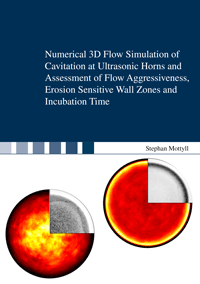
Shop : Details
Shop
Details
48,80 €ISBN 978-3-8440-6249-6Softcover194 pages104 figures417 g24 x 17 cmEnglishThesis
October 2018
Stephan Mottyll
Numerical 3D Flow Simulation of Cavitation at Ultrasonic Horns and Assessment of Flow Aggressiveness, Erosion Sensitive Wall Zones and Incubation Time
Cavitation erosion is closely related to the violent collapse of gaseous voids close to a solid surface, which results in high pressure loads at the material surface and ultimately in material damage. As a contribution to a better understanding of cavitation erosion mechanisms, a compressible inviscid finite volume flow solver with barotropic homogeneous liquid–vapor mixture cavitation model is applied to the standard erosion test case of an ultrasonic horn with stationary specimen and 0.5 mm gap width that exhibits attached cavitation at the horn tip. Void collapses and shock waves, which are closely related to cavitation erosion, are resolved, whilst dispersed bubbles are neglected. The computational results are compared to measured data as hydrophone, shadowgraphy and pressure sensor data as well as erosion test data, i.e. material surface topography profiles and incubation time.
For attached cavitation at the horn tip, cavity volume and topology, subharmonic oscillation frequency as well as the amplitude of propagating pressure waves are in good agreement with experimental data. For the evaluation of flow aggressiveness and the assessment of erosion sensitive wall zones, statistical analyses of wall-loads and of the multiplicity of distinct collapses in wall-adjacent flow regions are applied. Erosion sensitive wall zones are well predicted for both, horn tip and stationary specimen, and numerically predicted erosion probability is in good qualitative agreement with measured topography profiles of eroded duplex stainless steel samples after long-term runs. For the stationary specimen ultrasonic horn case, the analysis of near-wall load collectives, i.e. cumulative collapse rate vs. collapse pressure, reveals that the tip-attached coherent cavity is mainly contributing to erosion damage. A distinctive erosive ring shape at the horn tip can be attributed to frequent breakdown and re-development of a small portion of the attached cavity at each driving cycle, whereas the stationary specimen is rather unfrequently stressed at the end of each subharmonic cycle by violent collapses of the entire attached cavity.
The collapse load collectives show an exponential decrease towards higher pressures in accordance to experimental findings. An a posteriori projection of load collectives onto a reference grid eliminates the grid dependence effectively and allows scaling of load collectives to different reference grid sizes, which enables load collective calibration. Incubation time is numerically assessed by the coupling of calibrated collapse load collectives that are approximated and expanded in time with an erosion model for ductile materials. For a hydrodynamic cavitation case, calibration is achieved with respect to measured pressure sensor data, for which a spatial minimum incubation time in adequate agreement to experiments is determined. Virtual sensor load collectives at the stationary specimen ultrasonic horn case yield an a priori minor grid dependence and a good agreement to measurements, whereby sensor calibration becomes inapplicable, but can be obtained by an ‘inverse’ calibration with respect to measured incubation times. The calibrated reference grid size at the hydrodynamic cavitation case and the ultrasonic horn case clearly deviate and thus represents no universal parameter.
For attached cavitation at the horn tip, cavity volume and topology, subharmonic oscillation frequency as well as the amplitude of propagating pressure waves are in good agreement with experimental data. For the evaluation of flow aggressiveness and the assessment of erosion sensitive wall zones, statistical analyses of wall-loads and of the multiplicity of distinct collapses in wall-adjacent flow regions are applied. Erosion sensitive wall zones are well predicted for both, horn tip and stationary specimen, and numerically predicted erosion probability is in good qualitative agreement with measured topography profiles of eroded duplex stainless steel samples after long-term runs. For the stationary specimen ultrasonic horn case, the analysis of near-wall load collectives, i.e. cumulative collapse rate vs. collapse pressure, reveals that the tip-attached coherent cavity is mainly contributing to erosion damage. A distinctive erosive ring shape at the horn tip can be attributed to frequent breakdown and re-development of a small portion of the attached cavity at each driving cycle, whereas the stationary specimen is rather unfrequently stressed at the end of each subharmonic cycle by violent collapses of the entire attached cavity.
The collapse load collectives show an exponential decrease towards higher pressures in accordance to experimental findings. An a posteriori projection of load collectives onto a reference grid eliminates the grid dependence effectively and allows scaling of load collectives to different reference grid sizes, which enables load collective calibration. Incubation time is numerically assessed by the coupling of calibrated collapse load collectives that are approximated and expanded in time with an erosion model for ductile materials. For a hydrodynamic cavitation case, calibration is achieved with respect to measured pressure sensor data, for which a spatial minimum incubation time in adequate agreement to experiments is determined. Virtual sensor load collectives at the stationary specimen ultrasonic horn case yield an a priori minor grid dependence and a good agreement to measurements, whereby sensor calibration becomes inapplicable, but can be obtained by an ‘inverse’ calibration with respect to measured incubation times. The calibrated reference grid size at the hydrodynamic cavitation case and the ultrasonic horn case clearly deviate and thus represents no universal parameter.
Keywords: Ultrasonic horn; CFD; cavitation model; cavitation erosion; load collective; erosion sensitive wall zone; incubation time
Available online documents for this title
DOI 10.2370/9783844062496
You need Adobe Reader, to view these files. Here you will find a little help and information for downloading the PDF files.
Please note that the online documents cannot be printed or edited.
Please also see further information at: Help and Information.
Please also see further information at: Help and Information.
| Document |  | Document | ||
| Type |  | |||
| Costs |  | 36,60 € | ||
| Action |  | Purchase in obligation and download the file | ||
| Document |  | Table of contents | ||
| Type |  | |||
| Costs |  | free | ||
| Action |  | Download the file | ||
User settings for registered online customers (online documents)
You can change your address details here and access documents you have already ordered.
User
Not logged in
Export of bibliographic data
Shaker Verlag GmbH
Am Langen Graben 15a
52353 Düren
Germany
Am Langen Graben 15a
52353 Düren
Germany
Mon. - Thurs. 8:00 a.m. to 4:00 p.m.
Fri. 8:00 a.m. to 3:00 p.m.
Fri. 8:00 a.m. to 3:00 p.m.
Contact us. We will be happy to help you.



